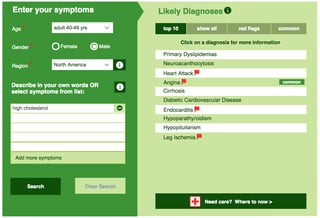- Privacy Policy
- Terms & Conditions
- Contact us
- ©Isabel Healthcare 2025
National Cholesterol Education Month | Everything about cholesterol
 September is National Cholesterol Education Month in the USA, and coming up in October it is the UK’s turn. The recommended cholesterol levels for a healthy lifestyle are 200mg/dL. More than 102 million American adults age 20 years or older have cholesterol above these levels. What’s more, 35 million of these people have levels of 240mg/dL or higher which puts them at high risk for heart disease. Many people are not aware of what their cholesterol levels are or even what their results mean when they are tested. Therefore, this is a great time to get your blood cholesterol and lipid levels checked and embrace learning a bit more about them. If they come up high, we have some advice on what you can do to lower your levels by making the correct food and lifestyle changes.
September is National Cholesterol Education Month in the USA, and coming up in October it is the UK’s turn. The recommended cholesterol levels for a healthy lifestyle are 200mg/dL. More than 102 million American adults age 20 years or older have cholesterol above these levels. What’s more, 35 million of these people have levels of 240mg/dL or higher which puts them at high risk for heart disease. Many people are not aware of what their cholesterol levels are or even what their results mean when they are tested. Therefore, this is a great time to get your blood cholesterol and lipid levels checked and embrace learning a bit more about them. If they come up high, we have some advice on what you can do to lower your levels by making the correct food and lifestyle changes.
What is cholesterol?
Cholesterol is a type of fatty substance called a lipid. Lipids are fundamental to the normal functioning of the body. Cholesterol is predominantly made by the liver but can be found in some foods as well, and is carried in the blood by proteins. When they combine they are called lipoproteins, of which there are two types, explained below. Hyperlipidemia (excess amount of lipids in the blood) can influence your health. High lipids or cholesterol doesn’t usually cause any symptoms but the consequences of having them in the blood can increase your risk of suffering from serious health conditions.
High-density lipoprotein (HDL)
This takes cholesterol away from the cells and back to your liver where it can be broken down or released from the body as a waste product. It is also known as “good cholesterol” and for this reason you want high levels of HDL cholesterol, as if your levels are high then it is being successful in removing the “bad cholesterol” or low-density lipoprotein from the body.
Low-density lipoprotein (LDL)
This transports cholesterol to the cells which need it for their normal function requirements. The problem is if there is an excess of LDL in the body then it can build up in the artery walls, restricting the blood flow to the heart, brain and rest of your body. This is known as ‘high cholesterol’ and can lead to increased risks of developing many diseases including:
- narrowing of the arteries (atherosclerosis)
- heart attack
- stroke
- transient ischemic attack (TIA)
- peripheral arterial disease (PAD)
- increased risks of blood clot
- coronary heart disease
- angina
To complicate matters even further, if you have high levels of LDL cholesterol and low levels of HDL cholesterol then the HDL cholesterol is unable to perform its role of removing the “bad cholesterol” LDL from the body as efficiently and your risk for developing these diseases is increased.
What causes high cholesterol?
Some things which increase your risk of having a high cholesterol level are:
- unhealthy diet especially if high levels of saturated fat
- smoking – a chemical in cigarettes called acrolein stops HDL working effectively
- diabetes
- high blood pressure (hypertension)
- family history of stroke
- family history of heart disease
- familial hypercholesterolaemia – this condition causes high cholesterol even in someone who eats healthily
- obesity
- large waist circumference
- lack of exercise
Diagnosis of high cholesterol
Adults
If you have any risk factors detailed above then a lipid profile may be ordered by your doctor or they may order it as part of your annual examination, to be done every five years. For accurate results patients are advised not to eat or drink anything apart from water for 12 hours prior to the blood being taken. The test ordered is a lipid profile or lipid panel and includes:
- Total cholesterol – this is a measure of your HDL level and LDL level
- HDL cholesterol – “good cholesterol”
- LDL cholesterol – “bad cholesterol”
- Triglycerides – another form of fat used by cells or tissues which are converted to energy
For an interpretation of the blood test results look at this chart from the Mayo Clinic. Please note that US and UK levels are measured using a different scale compared to other countries so please check the correct chart.
Children
Children can have high cholesterol as well, although it is a lot less common. The American Academy of Pediatrics (AAP) recommends, however, that all children between the ages of 9-11 years are screened for high cholesterol levels due to the growing problem of obesity in childhood. They also recommend a cholesterol test is taken for children over 2 years and not after 10 years for those children who have:
- Parents or grandparents who have had heart attacks or, stroke or blocked arteries at age 55 or earlier in men and 65 or earlier in women
- Parents or grandparents who have total blood cholesterol levels 240mg/dL or higher
- Those whose family background is unknown or who have characteristics associated with heart disease, smoking, stroke, obesity or diabetes.

Normal levels for test results in children Source: HealthChildren.org
What to do if you have high cholesterol
The most important weapon in controlling your cholesterol is lifestyle changes with regards to diet and exercise. Ensure you have a low-fat and high-fiber diet by eating more fruit, vegetables and whole grains. Adults should exercise for at least 2 hours 30 minutes a week including 1 hour 15 minutes of vigorous activity. Children between 6-17 years need 1 hour or more of physical activity each day. Maintaining a healthy weight, and not smoking or giving up smoking, are other measures which have a plethora of health benefits including better cholesterol levels.
If after making these diet and lifestyle changes for three months your levels remain problematic then your Doctor may suggest starting medication such as statins, bile-acid binding resins, cholesterol absorption inhibitors or medication to reduce your triglycerides.
Being aware of what tests you are having, and what their results mean is a vital part of taking control of your health. Ensuring you lower your risk factors by leading a healthy lifestyle is important, especially as you become older. Using a symptom checker like Isabel can help you make sense of your symptoms, and discuss tests and treatments with your doctor.

Check your blood results with the Isabel Symptom Checker and see potential disease causes to discuss with your Doctor

Mandy Tomlinson
Mandy has worked for Isabel Healthcare since 2000. Prior to this, she was a Senior Staff Nurse on the Pediatric Infectious disease ward and high dependency unit at one of London's top hospitals, St Mary’s in Paddington which is part of Imperial College Healthcare NHS Trust. Her experience in the healthcare industry for the past 33 years in both the UK and USA means she's a vital resource for our organization. Mandy currently lives and works in Scottsdale, Arizona.
Subscribe Here!
Recent Posts
Isabel DDx Companion with ChatGPT Integration - to help you diagnose even faster
At Isabel Healthcare, we’ve always been driven by one goal: to make clinical reasoning faster,..Virtual Triage: Do more questions lead to better patient outcomes?
One of the common misconceptions related to virtual triage / symptom checker tools is that the more..List Of Categories
- Differential Diagnosis Decision Support
- Differential diagnosis
- Symptom Checker
- Symptoms
- Medical Error
- Patient Disease Information
- Disease
- Clinical Decision Support
- Diagnostic Decision Support
- Isabel 1 Minute Read
- Diagnosis Error
- Diagnosis Skills Cases
- Healthcare Informatics
- Clinical Reasoning
- Evidence-based Medicine
- Medical Education
- Patient Engagement
- Symptom Triage
- Nurse Practitioner Education
- Nursing Decision Support
- Partnership
- Public Health
- COVID-19
- EHR
- Patient Empowerment
- Patient Safety
- rare disease

Start your FREE Trial today
Try the Isabel Pro DDx generator for 30-days - no payment card details required.




